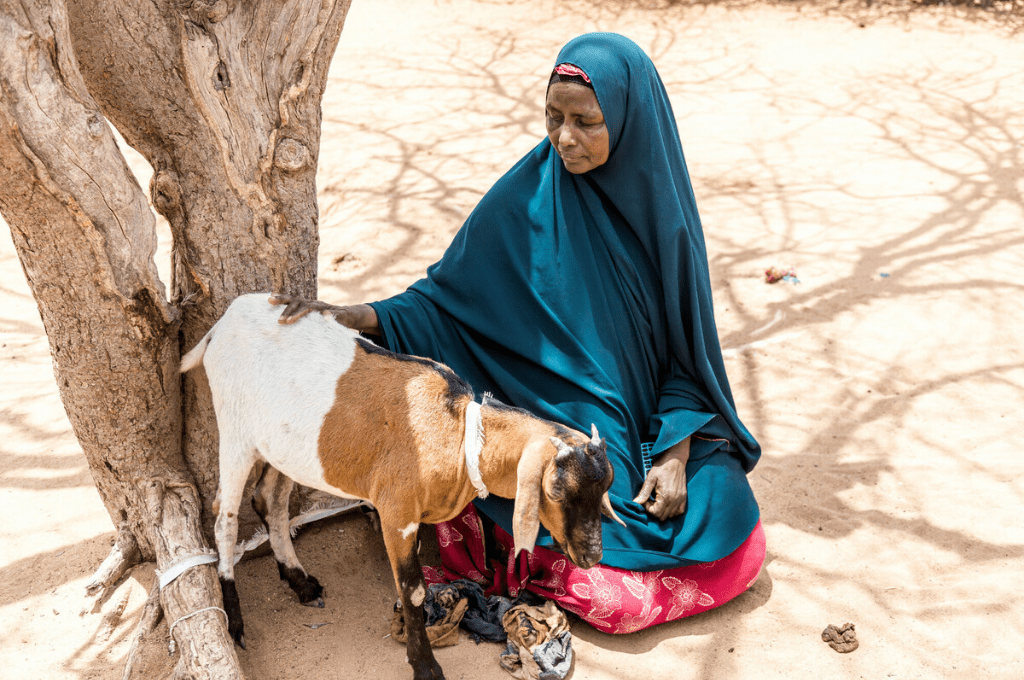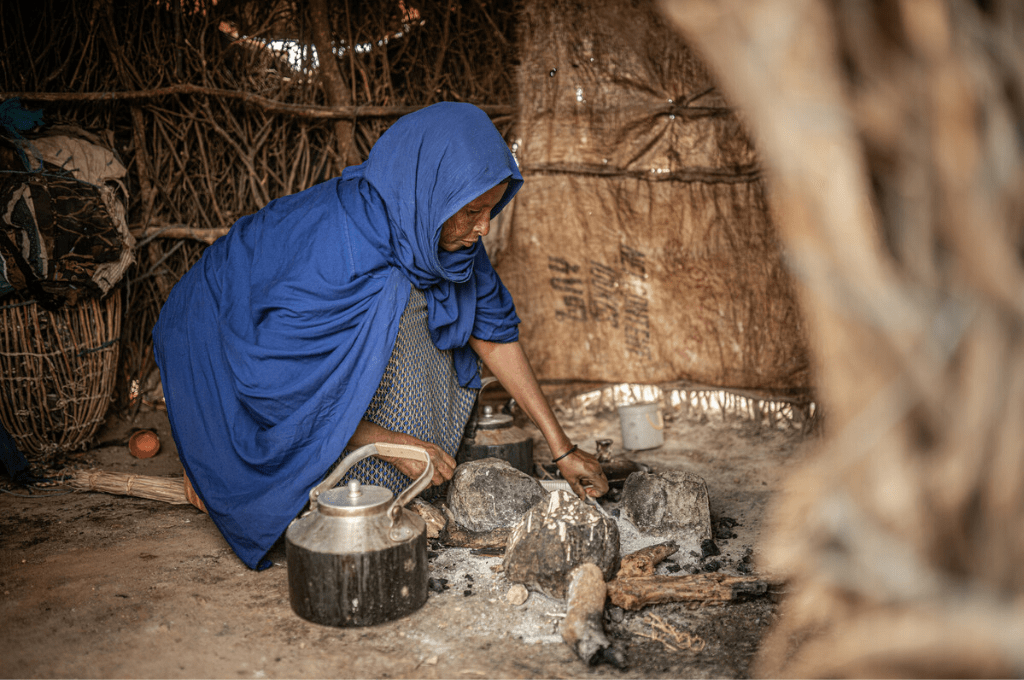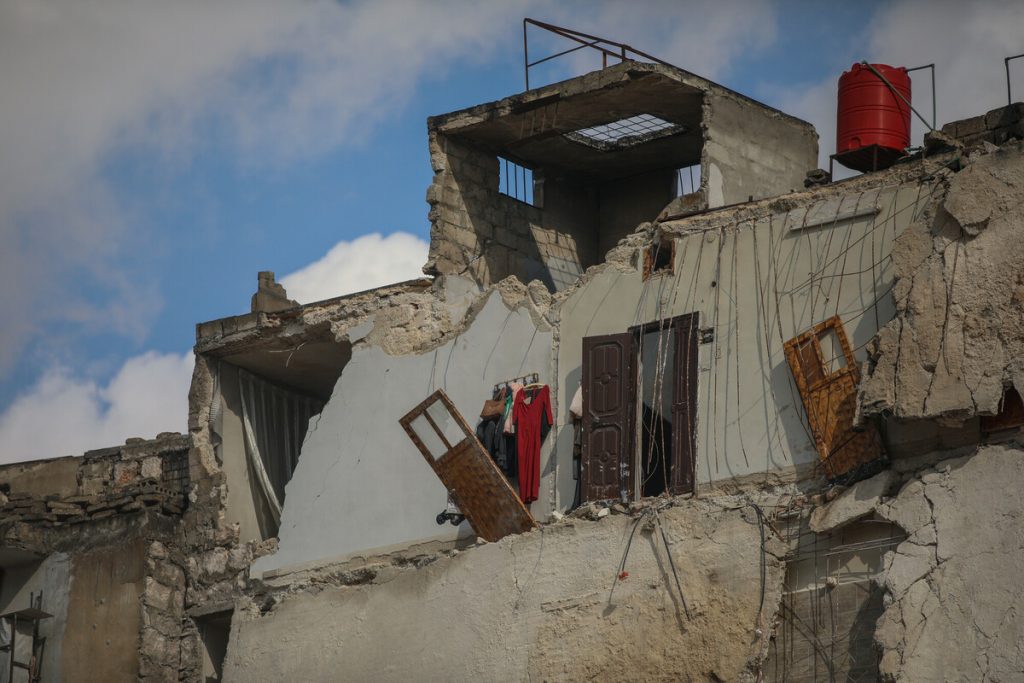What’s Causing the Hunger Crisis in East Africa?
Oxfam is responding in four countries and urging more international assistance to help people facing severe hunger due to climate change, conflict, and economic shocks.
"The long drought has brought lots of problems," says Halima Wario Wadoyo, a mother of seven from Modogashe, a small town in eastern Kenya, "but there is nothing we can do."
"Before the drought, we used to get water from the rains," she explains. "We'd fetch water from the nearby stream. But it has dried up."
Halima lost 28 of her 30 goats in the last few months, and one of the two still alive is ill. "It's sick due to a lack of water and food," she says. She adds it's hard enough already to get water for her children or herself, let alone the animals. When her family is lucky, she says, they have a meal a day.

Halima tends to her sick goat. Only two out of her 30 goats survived Kenya's ongoing climate change-fueled drought. Photo: Loliwe Phiri/Oxfam
What's the Backdrop of this Crisis?
Large portions of East Africa are suffering their worst drought in four decades. With forecasters predicting the lack of rain will persist for a fifth consecutive season, humanitarian aid funding falling short of what's needed, and rising food, fuel, and fertilizer prices due partly to Russia's invasion of Ukraine, the region is facing a humanitarian disaster.
More than 23 million people in Ethiopia, Kenya, and Somalia are struggling to get enough food. The worst-hit areas are hurtling toward famine.
Locusts, which thrive in hot and dry conditions, have wiped out crops across large parts of eastern Africa. Ethiopia, Somalia, and South Sudan have also been contending with internal conflict that's disrupted farming and made it challenging to distribute humanitarian aid:
- In Somalia, the militant group al-Shabaab has been trying to topple the government since 2006.
- In Ethiopia, the government and rebels from the northern Tigray region fought a civil war that dragged on for more than 16 months before a truce was agreed upon in March. Fighting flared again in September, raising fears of a return to all-out war.
- South Sudan has been embroiled in a civil war since 2013 when unresolved tensions between ethnic groups erupted into fighting that spread all over the country.
LEARN MORE: How Extreme Hunger Affects Lactating Mothers And Babies In Ethiopia
How Dire is the Situation?
In Somalia alone, people are experiencing the most atrocious hunger crisis in living memory. It's even worse than the 2011 famine that claimed the lives of over a quarter of a million people. Almost one in six people in the country are now facing extreme hunger.
While withering droughts afflict Ethiopia, Kenya, and Somalia, climate change-driven erratic weather has resulted in record-breaking rains and floods affecting two-thirds of South Sudan. Over 70 per cent of its 11 million population depends on humanitarian assistance.
One person is likely to die of hunger every 36 seconds between now and the end of the year in Ethiopia, Kenya and Somalia, Oxfam warned earlier this month.
More than six million children face or are already suffering acute malnutrition across Ethiopia, Kenya, Somalia, and South Sudan.

Amina Ibrahim and her family fled their home in Qararo, Ethiopia, in 2017 after losing their 150 sheep and 15 camels to the drought and surviving an outbreak of a deadly diarrheal disease in their village. Since then, the family has lived in Gunagado, along with 600 other climate-displaced families, where Oxfam and other organizations provide clean water, food, and sanitation and hygiene services. Photo: Pablo Tosco/Oxfam
How is Oxfam Preventing Extreme Hunger?
Oxfam works with local organizations to reach over 1.8 million people across Ethiopia, Kenya, Somalia, and South Sudan.
Ethiopia
Oxfam has responded to the crisis in the Tigray and Amhara regions since November 2020. With our local partners, we've reached more than 105,000 people across the three areas affected by the conflict in northern Ethiopia. In 2023, our work seeks to reach 750,000 people with emergency food packages, cash transfers, clean water, sanitation, and hygiene kits.
Kenya
Oxfam works with a network of organizations in northern Kenya to provide emergency cash to help people buy food and other essential items. So far, this cash scheme has reached 40,000 people. We're also repairing wells and other water systems and promoting good hygiene practices to help people prevent COVID-19 and other diseases in eight of the most hard-to-reach and worst-affected counties. Oxfam aims to assist 300,000 people struggling to get food.
Somalia
Oxfam works with local organizations, like KAALO Aid and Development, to provide lifesaving water, sanitation, and health support. Together, we are drilling wells, distributing cash, seeds, and tools, and training farmers in small-scale greenhouse farming. Oxfam intends to reach 420,000 people across Somalia.
South Sudan
Oxfam and local partners provide cash grants to farmers to purchase vegetable seeds and tools and to families to buy food and other essentials. We provide safe water through the rehabilitation of water points like boreholes. Oxfam aims to reach 400,000 people across the country.
READ MORE: What connects the war in Ukraine to East Africa's hunger crisis?
The clock is ticking inexorably towards famine, and more and more people are dying as hunger tightens its grip. The alarm has been sounding for months, but donors are yet to wake up to the terrible reality. With another failed rains expected, failure to act will turn a crisis into a full-scale catastrophe.
Other Ways We're Helping
Oxfam advocates for governments to respond to this crisis with humanitarian assistance while also calling for investing in programs and services that fight inequality, help people improve their lives over the long term, and reduce their vulnerability to climate change.
There's a total funding gap of more than $3 billion in United Nations appeals for Somalia, Ethiopia, Kenya and South Sudan.
"The clock is ticking inexorably towards famine, and more and more people are dying as hunger tightens its grip," says Parvin Ngala, regional director for Oxfam Horn East and Central Africa. "The alarm has been sounding for months, but donors are yet to wake up to the terrible reality. With another failed rains expected, failure to act will turn a crisis into a full-scale catastrophe."
You can make a difference in alleviating hunger. Donate now to support mothers like Halima in Kenya and other East African countries with lifesaving food and supplies.

